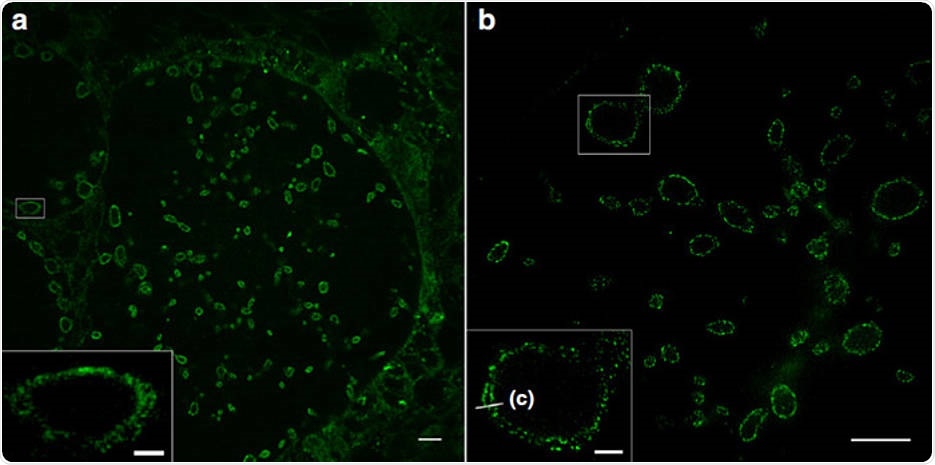Expansion microscopy, abbreviated as ExM, allows scientists to image cells and their components with a spatial resolution down to 200 nm.

Sphingolipid expansion microscopy (ExM) of a tenfold expanded cell infected with chlamydia. The bacterial membranes are marked green; the inner and outer membranes of the bacteria can be distinguished (c). Under (a) confocal laser scanning and under (b) structured illumination microscopy (SIM). Scale bars: 10 and 2 microns in the small white rectangles, respectively. Image Credit: Arbeitsgruppe Sauer/University of Würzburg.
To perform this task, the proteins of the sample being studied are cross-linked into a swellable polymer. When the intermolecular interactions have been destroyed, the samples can be expanded several times using water. This provides in-depth insights into their structures.
This method was previously limited to proteins. In the journal Nature Communications we are now presenting a way of expanding lipids and thus cell membranes.”
Markus Sauer, Professor and Expert in Super-Resolution Microscopy, Biocentre of Julius-Maximilians-Universität Würzburg
Thomas Rudel (microbiology) and Jürgen Seibel (chemistry), both professors from Julius-Maximilians-Universität (JMU) also contributed the publication.
Synthetic lipids are marked and expanded
The team, led by Jürgen Seibel, has produced functionalized sphingolipids, which are key components of cell membranes. When these lipids are introduced to cell cultures, they become integrated into the cell membranes. These lipids can be subsequently marked with a dye and extended 4 to 10 times in a swellable polymer.
The JMU team showed that this technique—along with structured illumination microscopy (SIM)—makes it feasible to image different kinds of membranes and their interactions with proteins, for the first time and with a resolution of 10 to 20 nm; these membranes include cell membranes, the outer and inner cell nuclear membrane, as well as the membranes of intracellular organelles, like mitochondria.
Focusing on bacteria and viruses
Moreover, the sphingolipids efficiently integrate into bacterial membranes. For the first time, this implies that pathogens, like Chlamydia trachomatis, Neisseria gonorrhoeae, and Simkania negevensis can currently be observed in infected cells with a resolution that was only achieved with electron microscopy in the past. Even the outer and inner membranes of Gram-negative bacteria can be differentiated from one another.
With the new super-resolution microscopic methods, we now want to investigate bacterial infection mechanisms and causes of antibiotic resistance. What we learn in the process could possibly be used for improved therapies.”
Thomas Rudel, Professor and Expert on Bacterial Infections, University of Würzburg
The sphingolipids may also combine into the viral membrane. If this proves successful, the interactions of corona viruses with cells could be examined for the first time through high-resolution light microscopy.
Source:
Journal reference:
Götz, R., et al. (2020) Nanoscale imaging of bacterial infections by sphingolipid expansion microscopy. Nature Communications. doi.org/10.1038/s41467-020-19897-1.